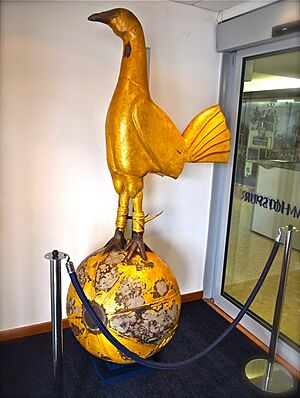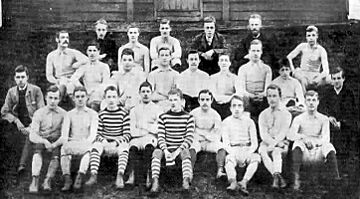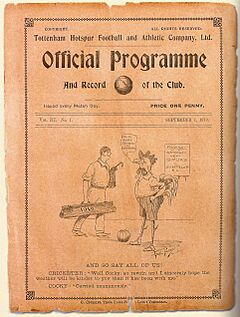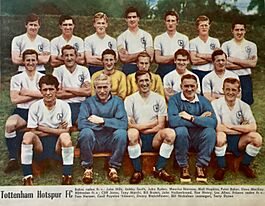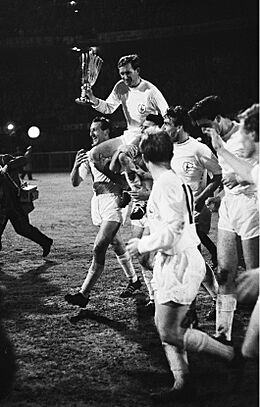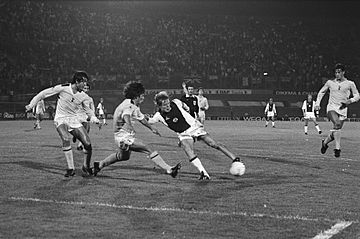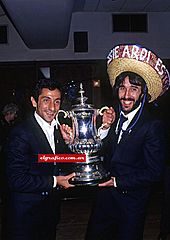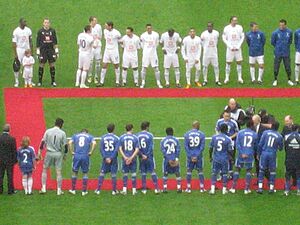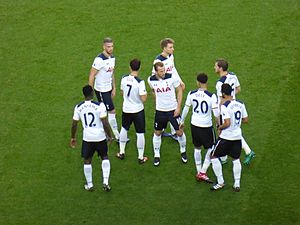History of Tottenham Hotspur F.C. facts for kids
Tottenham Hotspur Football Club, often called "Tottenham" or "Spurs," is a famous football club from Tottenham, north London, England. It was started in 1882 by a group of schoolboys who loved cricket and wanted to keep playing sports in winter. They first called themselves "Hotspur Football Club" and changed to "Tottenham Hotspur Football Club" in 1884.
Spurs became a professional club in 1895. They made history in 1901 by winning the FA Cup, becoming the only non-League club to do so since the Football League began. They have won the FA Cup seven more times, the Football League twice, the League Cup four times, the UEFA Cup twice, and the UEFA Cup Winners' Cup in 1963. This made them the first English team to win a UEFA competition. In the 1960–61 season, Tottenham was the first team in the 20th century to win "The Double" – meaning they won both the league title and the FA Cup in the same year!
Tottenham played in the Southern League before joining the Football League Second Division in 1908. They quickly moved up to the First Division. After some ups and downs, the club became very successful in the 1960s. Tottenham was also one of the founding members of the Premier League in 1992 and is now considered one of the top six clubs in England.
Many great managers have led Spurs. John Cameron was the first to win a major trophy, the 1901 FA Cup. Bill Nicholson led the team during their most successful period in the 1960s, including the Double-winning season. Later, Keith Burkinshaw won two FA Cups and a UEFA Cup, and Terry Venables won the FA Cup in 1991.
Spurs first played on public land at Tottenham Marshes. By 1888, they moved to Northumberland Park. In 1899, the club moved to White Hart Lane, where they built a stadium and played until 2017. Their new home, Tottenham Hotspur Stadium, was finished in 2019 on the same site. While the new stadium was being built, Spurs played their home games at Wembley Stadium.
Contents
- How Tottenham Hotspur Started
- Early Years of the Club
- Early Years in the Football League (1908–1949)
- Arthur Rowe and the League Title (1949–1958)
- Bill Nicholson and the Glory Years (1958–1974)
- Decline and Revival (1974–1984)
- New Managers and Challenges (1984–1993)
- Premier League Era Begins (1992–2004)
- Rise and the Champions League (2004–2014)
- Pochettino Era (2014–2019)
- Recent Managers (2019–Present)
- See also
How Tottenham Hotspur Started
The Hotspur Football Club began in 1882. It was formed by schoolboys, mostly 13 or 14 years old, from Saint John's Middle Class School and Tottenham Grammar School. These boys were already part of a cricket club and wanted to play sports during the colder months. Robert Buckle and his friends Sam Casey and John Anderson came up with the idea.
The boys decided to call their club "Hotspur." This name honored Sir Henry Percy, also known as Harry Hotspur, a famous rebel from history. His family used to own land in the Tottenham area.
In 1883, John Ripsher, a local YMCA warden, helped the boys organize the club. He became the first president and treasurer. In April 1884, to avoid confusion with another club called Hotspur, they changed their name to Tottenham Hotspur Football Club. People started calling them "Spurs" as early as 1883, and they are also known as "the Lilywhites" because of their white jerseys.
Early Years of the Club
In the beginning, the boys played their matches on public land at Tottenham Marshes. They had to mark out their own pitch and sometimes even defend it from other teams! Local pubs were used as changing rooms. Their first recorded match was on September 30, 1882, which they lost 2–0. Their first competitive match was in the London Football Association Cup in 1885, which they won 5–2.
As the club grew, more people came to watch their games. By 1888, Tottenham moved to Northumberland Park, where they could charge admission fees. This helped the club earn money. In the early 1890s, a cup game could attract thousands of fans. They built their first small stand with over 100 seats in 1894.
Spurs changed their team colours several times in the early years. They started with navy-blue shirts and white shorts. They then tried light blue and white, then red shirts and blue shorts, and even chocolate brown and gold stripes. Finally, in the 1898–99 season, they settled on the famous white shirts and navy-blue shorts that they still wear today.
Becoming Professional
In 1893, Tottenham faced a small problem when a player was given money for boots, which was against amateur rules. This led to a suspension, but it also made the club more famous and gained them sympathy. This publicity helped them attract local businessman John Oliver, who became chairman in 1894.
To compete with better teams, the club decided to become professional on December 20, 1895. They then joined Division One of the Southern League in 1896. They quickly signed their first professional players, including John Cameron, who became player-manager in 1899. Cameron led Spurs to their first major trophies: the Southern League title in 1900 and the FA Cup in 1901.
Moving to White Hart Lane
In 1898, a large crowd at Northumberland Park caused a refreshment stand to collapse, injuring some fans. This made the club look for a new, safer ground. In 1899, they moved a short distance to land behind the White Hart pub, which became known as White Hart Lane.
The first game at White Hart Lane was a friendly match against Notts County on September 4, 1899, which Spurs won 4–1. Five days later, they won their first competitive game there against Queens Park Rangers. In 1900, Tottenham won the Southern League, earning them the nickname "Flower of the South" from the press.
The Historic 1901 FA Cup Win
Tottenham first played in the FA Cup in 1894. In the 1901 FA Cup, they reached the final after beating several strong teams. The final against Sheffield United was played at Crystal Palace, with over 110,000 spectators – the largest crowd ever for a football match at that time. The game ended in a 2–2 draw.
In the replay match on April 27, 1901, Spurs won 3–1. By winning the FA Cup, Tottenham became the only non-League club to achieve this since the Football League started in 1888. After the win, a Spurs director's wife tied blue and white ribbons to the FA Cup, starting a tradition that continues today. This victory also began a trend of Spurs winning major trophies in years ending in a "one," like the FA Cup in 1921, 1961, 1981, and 1991, and the League title in 1951 and 1961.
Early Years in the Football League (1908–1949)
Joining the Football League
In 1908, Tottenham joined the Football League Second Division. They won their first league game 3–0 against Wolverhampton Wanderers. They were promoted to the First Division in their very first year!
The Cockerel Emblem
In 1909, a bronze cockerel statue was placed on top of the West Stand at White Hart Lane. The cockerel became the club's emblem because Harry Hotspur, the club's namesake, was known for wearing fighting spurs in battle. Spurs were also worn by fighting cocks, which led to the cockerel symbol.
FA Cup Victory in 1921
After World War I, Tottenham returned to Division One in 1919, winning the Division Two Championship with a record 70 points. The next year, they reached their second FA Cup final. On April 23, 1921, Spurs beat Wolverhampton Wanderers 1–0 in the final, winning their second FA Cup. After this victory, Spurs players started wearing the cockerel emblem on their shirts.
During this time, the club also set up a "nursery club" at Northfleet, where many young players, including future legend Bill Nicholson, started their careers.
Challenges and Relegation
After their 1921 success, Spurs struggled for a while. In the 1927–28 season, they were unexpectedly relegated from the First Division. They spent many years in the Second Division, trying to get back to the top.
Wartime Football
During World War II, league football was stopped, but matches continued to be played in regional leagues. White Hart Lane was even used as a factory to make gas masks and other equipment. Spurs shared their stadium with Arsenal for a time when Arsenal's ground was used for air raid precautions.
Arthur Rowe and the League Title (1949–1958)
Winning the League Title
In 1949, Arthur Rowe became Spurs manager. He introduced a new way of playing called "Push and Run." This style involved quick passing and players moving into open spaces. It was very successful! In the 1949–50 season, Spurs had an amazing unbeaten run of 23 games and won the Second Division easily, returning to the top flight.
The next season, 1950–51, was even better. Spurs won their first ever First Division Championship title! The team, including legendary players like Alf Ramsey, Bill Nicholson, and captain Ron Burgess, finished ahead of Manchester United. This team is often considered one of the best in Tottenham's history.
The "Spurs Way"
The "Push and Run" tactics developed by Arthur Rowe became known as the "Spurs Way." It was all about making the game simple and quick, with players constantly moving and passing the ball. This attacking style of play became a key part of Tottenham's identity.
After winning the title, Spurs finished second in the 1951–52 season. However, the team started to decline as players got older and other teams learned to counter their style. Arthur Rowe's health suffered from the stress, and he resigned in 1955.
Bill Nicholson and the Glory Years (1958–1974)
In October 1958, Bill Nicholson became manager. He had been with Tottenham since 1936, serving in many roles. Nicholson became the most successful Spurs manager ever, leading the club to major trophies for three seasons in a row in the early 1960s.
In his first game, Spurs beat Everton 10–4, which was a club record win at the time. Nicholson signed key players like Dave Mackay and John White, who would become vital to the team's success.
The Double Winners
The 1960–61 season was incredible. Spurs started with 11 straight wins, a record for English top-flight football at the time. They won the league title on April 17, 1961, with three games left to play.
The team, led by captain Danny Blanchflower and featuring stars like Bobby Smith and Cliff Jones, also reached the FA Cup final. They beat Leicester City 2–0, becoming the first team in England to win "The Double" (league title and FA Cup) in the 20th century.
First European Triumph
In the 1961–62 season, Spurs played in a European competition for the first time. Fans started singing "Glory Glory Hallelujah" during these matches, which became the club's anthem. They reached the semi-finals of the European Cup.
A month later, Spurs won the FA Cup again, beating Burnley. They had signed Jimmy Greaves for a record fee, and he became the club's top goal scorer of all time.
In the 1962–63 European Cup Winners' Cup, Spurs reached the final. On May 15, 1963, they beat Atlético Madrid 5–1 in Rotterdam. This made Tottenham the first British team to win a European trophy!
Continued Success
After the Double-winning team started to break up, Nicholson rebuilt the squad with new players like Alan Mullery, Pat Jennings, and Alan Gilzean. This new team won the FA Cup in 1967.
Spurs also won their first League Cup in 1971, beating Aston Villa. They won the League Cup again in 1973. In 1972, they won the first-ever UEFA Cup, becoming the first British team to win two different European trophies. In total, Bill Nicholson won eight major trophies in 16 years, making his time the most successful in the club's history.
Decline and Revival (1974–1984)
After a period of great success, the team started to decline. Bill Nicholson resigned in 1974. Terry Neill took over, and Spurs barely avoided relegation in 1975. Neill later left to manage Arsenal, and his assistant, Keith Burkinshaw, became manager.
Relegation and Return
In Burkinshaw's first year, 1976–77, Tottenham was relegated from the First Division after 27 years. This was a tough time for the club. However, the team immediately won promotion back to the top flight in the 1977–78 season, securing their spot in the very last game.
Cup Wins and European Success
In 1978, Burkinshaw made headlines by signing two Argentinian international players, Osvaldo Ardiles and Ricardo Villa. This was unusual for English football at the time. Young players like Glenn Hoddle and Steve Perryman also became key members of the team.
Spurs started the 1980s by winning the FA Cup in 1981, with a famous winning goal from Ricardo Villa in the replay. They won the FA Cup again the next season, in 1982.
In 1984, Tottenham reached the final of the UEFA Cup. After drawing both legs against Anderlecht, Spurs won in a penalty shootout, with goalkeeper Tony Parks making a crucial save. This was the third major trophy won under Burkinshaw in the 1980s.
New Managers and Challenges (1984–1993)
After Burkinshaw left, Peter Shreeves and then David Pleat managed the team. Spurs had some good seasons, including a strong third-place finish in 1985. However, a ban on English clubs from European competitions after the Heysel disaster meant they couldn't play in Europe. In 1987, Spurs reached the FA Cup final but lost to Coventry City.
Terry Venables, a former Spurs player, became manager in 1987. He signed exciting players like Paul Gascoigne and Gary Lineker. These players helped Spurs finish third in the league in 1990.
FA Cup Win and Club Changes
In the 1990–91 season, Spurs had a memorable FA Cup run. They beat Arsenal in the semi-final with a fantastic free kick from Gascoigne. In the final against Nottingham Forest, Gascoigne suffered a serious knee injury. Spurs still won the match 2–1 after extra time, becoming the first team to win eight FA Cups.
Around this time, the club faced financial difficulties. In 1991, businessman Alan Sugar joined forces with Terry Venables to take control of the club. This partnership led to some changes in how the club was run. In 1993, after a disagreement, Alan Sugar controversially dismissed Terry Venables from the club.
Premier League Era Begins (1992–2004)
Spurs was one of the five clubs that helped create the Premier League, which became the top division of English football in 1992. Tottenham signed important players like Darren Anderton and Teddy Sheringham for the first Premier League season.
New Managers and Ups and Downs
After Venables left, former player Osvaldo Ardiles became manager. He tried an exciting, attacking style of play with five forward players, including German striker Jürgen Klinsmann. This team was called the "Famous Five." While they played some thrilling football, they also conceded many goals. Ardiles was dismissed in 1994.
Gerry Francis took over and helped the club climb the league table. Klinsmann was a top scorer but left in 1995. Francis later resigned in 1997. Christian Gross then managed the team, and Spurs narrowly avoided relegation in 1998.
By the end of the 1990s, White Hart Lane was fully renovated into an all-seater stadium with a capacity of about 36,240.
George Graham and League Cup Win
In 1998, former Arsenal manager George Graham was hired. Despite some fans being unhappy due to his Arsenal connection, Graham led Spurs to win the League Cup in 1999. In the final against Leicester City, Allan Nielsen scored a dramatic winning goal in the last minute.
In 2001, Alan Sugar sold his shares in the club, and Daniel Levy became the new chairman. George Graham was then sacked.
Glenn Hoddle's Return
Former Tottenham player Glenn Hoddle became manager in 2001. That summer, club captain Sol Campbell made a controversial move to rivals Arsenal, which upset many Spurs fans. Hoddle signed experienced players like Teddy Sheringham (who returned to Spurs) and Robbie Keane. Spurs reached the League Cup final in 2002 but lost. Hoddle was sacked in 2003 after a poor start to the season.
Rise and the Champions League (2004–2014)
In 2004, Jacques Santini became head coach but left after only 13 games. Martin Jol then took over. He signed important players like Edgar Davids, Dimitar Berbatov, and Gareth Bale.
In the 2005–06 season, Spurs had a great run and were close to qualifying for the Champions League, but they narrowly missed out on the last day. They finished fifth for two seasons in a row, earning a spot in the UEFA Cup.
In 2007, Martin Jol was replaced by Juande Ramos. Under Ramos, Spurs won the League Cup in February 2008, beating Chelsea 2–1 in the final. However, the next season started very poorly, and Ramos was dismissed.
Harry Redknapp's Impact
Harry Redknapp became manager in October 2008. He quickly turned the team's fortunes around, moving them out of the relegation zone. Key players like Jermain Defoe and Peter Crouch returned or joined the club.
In the 2009–10 season, Spurs had a record 9–1 home win against Wigan Athletic. They also beat Arsenal in the Premier League for the first time. Spurs finished fourth, qualifying for the Champions League for the first time in their history.
In the 2010–11 Champions League, they topped their group and reached the quarter-finals, where they lost to Real Madrid. Redknapp was dismissed in 2012 after contract talks failed.
Villas-Boas and Sherwood
André Villas-Boas became manager in 2012. The club signed players like Jan Vertonghen and Hugo Lloris, while Luka Modric left for Real Madrid. Spurs finished fifth in the 2012–13 season, just missing out on a Champions League spot.
In 2013, Gareth Bale moved to Real Madrid for a world-record transfer fee. This money was used to sign several new players, including Christian Eriksen and Erik Lamela. Villas-Boas was dismissed in December 2013, and former player Tim Sherwood took over as a temporary manager. Sherwood led Spurs to a sixth-place finish but was sacked in May 2014.
Pochettino Era (2014–2019)
Mauricio Pochettino was appointed manager in May 2014. He focused on developing young players like Harry Kane, Dele Alli, and Eric Dier. In the 2015–16 season, Spurs had a much-improved performance and challenged for the league title, eventually finishing third.
The 2016–17 season was even better. Spurs finished second in the Premier League with their highest-ever points total. They also finished above Arsenal for the first time in 22 years!
The New Stadium
Construction of a new stadium began next to White Hart Lane in 2015. The new Tottenham Hotspur Stadium has a seating capacity of over 62,000, much larger than White Hart Lane's 36,000.
Spurs played their last game at White Hart Lane on May 14, 2017, winning 2–1 against Manchester United. White Hart Lane was then demolished to complete the new stadium. For the 2017–18 season, all home games were played at Wembley Stadium.
The new Tottenham Hotspur Stadium officially opened on April 3, 2019. Son Heung-min scored the first official goal in the new stadium in a 2–0 win against Crystal Palace.
In the 2018–19 season, Tottenham reached their first-ever Champions League final! They had dramatic wins against Manchester City and Ajax, with Lucas Moura scoring a hat-trick in the semi-final. However, they lost 2–0 in the final.
Recent Managers (2019–Present)
The 2019–20 season started poorly, and Mauricio Pochettino was sacked in November 2019. José Mourinho became the new coach. The season was affected by the COVID-19 pandemic. Mourinho led Spurs to qualify for the Europa League.
In the 2020–21 season, Harry Kane and Son Heung-min formed a strong partnership, helping Spurs reach the top of the league table in November. However, results declined, and Mourinho was dismissed in April 2021, just before the League Cup final. Ryan Mason, a former Spurs player, took over as interim coach. Tottenham lost the League Cup final and finished seventh in the league.
In 2021, Nuno Espírito Santo was named manager but was replaced by Antonio Conte after only four months. Conte guided Spurs back to a Champions League spot at the end of the 2021–22 season. Conte left in March 2023, and Ryan Mason again served as interim head coach.
In June 2023, Ange Postecoglou was appointed manager. He had a fantastic start to the 2023–24 season, going unbeaten in the first 10 games, which was Tottenham's best start in a top-flight season since the famous 1960–61 Double-winning year.
See also
- List of Tottenham Hotspur F.C. records and statistics
- List of Tottenham Hotspur F.C. players
- List of Tottenham Hotspur F.C. managers


